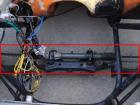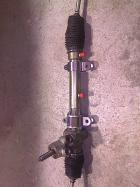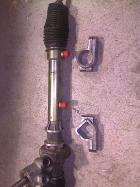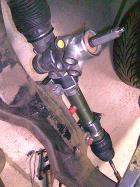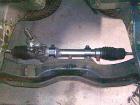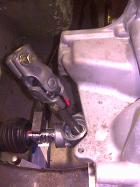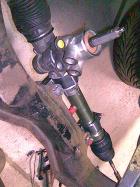Rack & Pinion has been adapted to many Datsun 1200s, but they were all one-off, undocumented swaps. Below is some information intended to foster development of the art.
Contents |
Rack And Pinion Overview
Consensus:
- NOT recommended for circuit or road racing
- Recommended for Drag Racing
- Jury's out on how well it works for a street car. Those who have done it report good success, those who haven't say the engineering does not add up. See the Considerations section below
GM Opel-built Holden Barina R&P in Datsun 1200:
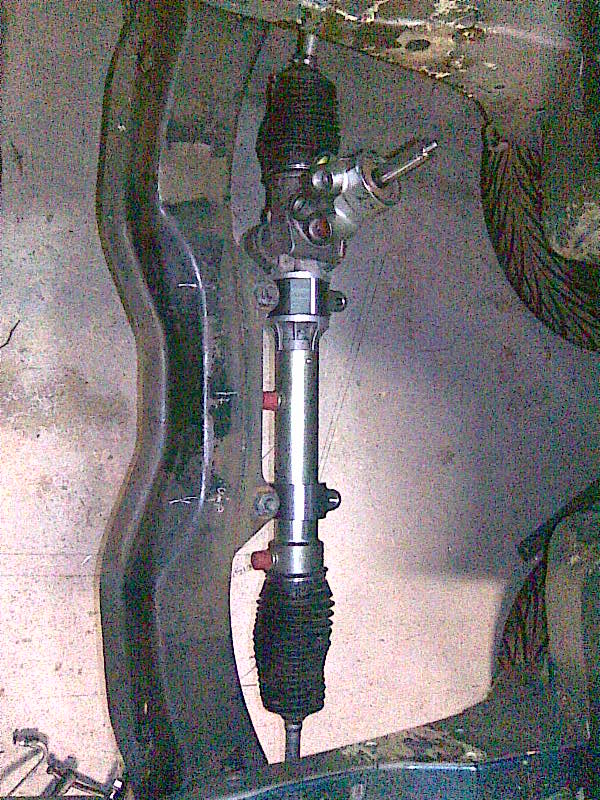 photo
photo 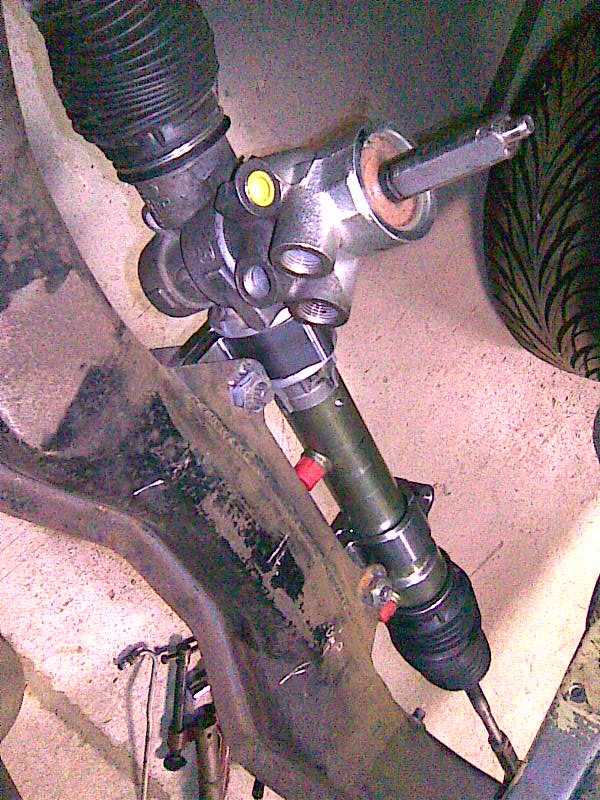 photo
photo  photo
photo 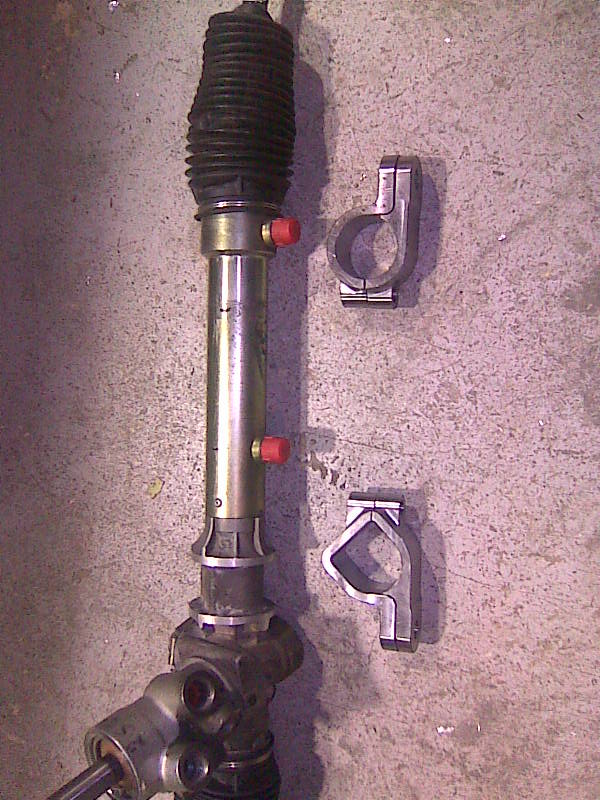 photo
photo 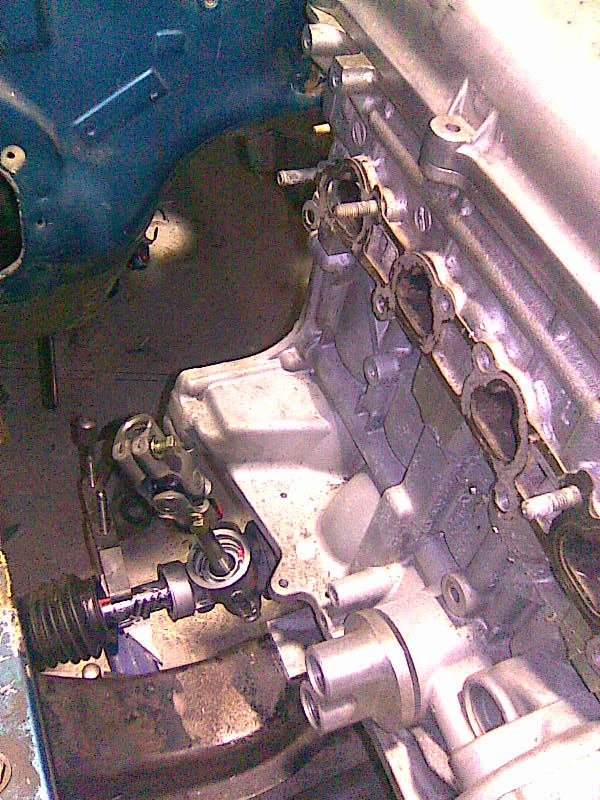
Discussions: * 1200 steering box rebuild/replace - what options? * Rack and pinion steering for Datsun 1200
Has anyone ever done it? Yes...
- Race cars with front tube frame (custom suspension and steering geometry)
- dat383 has fitted rack and pinion steering to a 1200 drag racer
- 1200 with full Escort front suspension (rack + struts + steering arms matched)
- wards fitted a Nissan Micra box to his ute
- maddatto is experimentng on a KB Laser fitment
- Bob Cooper fitted a Mini rack to his Datsun 1200
- Janspeed racing 1200, Mini rack?
- 1200 Coupe rally car from UK
There are several Datsun 510s with rack and pinion steering swaps. One uses a rack from a Datsun 200SX. Here's what he did:
- Move the engine crossmember back a couple inches (which necessitates changes to the engine mounts)
- Weld simple flat brackets to the x-member so the rack can be bolted on
- Cut the tie-rod ends and weld them back shorter (make sure you have an expert welder do that). For proper handling, they need to be exactly the same length overall as the A-arm overall lengths
- Use a newer steering column that has a flex-joint on the end. He used a 200SX column.
The swap had three u-joints and a fairly big angle from the end of the column to the rack, but he said it works great, much better than the stock 510 steering box. No slop!
Would it be better to cut the steering arms shorter and rethread them for the tie-rod ends?
wards said:
I agree this project is not for a novice , I have changed my approach many times as i have discovered pluses and minuses in my geometry , as with any motorsport catergory it's a compromise to achieve a workable result . My aim is to build in as much adjustability as possible to try to cover all bases .
Gemini Swap
Dat383 used a Holden Gemini (Isuzu) steering rack in front of the crossmember.
- Brackets are fabricated and welded to the crossmember. Because this fits to the front of the crossmember, while the Datsun steering was behing the xmember, swap the complete strut/brake/LCA assemblies from left to right.
- Shortened the Gemini rack ends and then re-thread them to suit.
- The front radius arms needed to have a bend pressed into them to clear the tie rod ends when the suspension is on the bump stops.
- Modify the standard 1200 steering colum to suit:
- Cut the outside of the column at the steering box and fabricate a plate out of steel, using the original rubber locator as a guide.
- Drill a hole in the plate the same size as the outer diameter of the column
- Weld the plate to the column.
- With the modified column fitted to the car and the inner steering shaft coming out, make a short steering shaft with two small uni-joints to join the colum and rack together.
Electric Rack & Pinion
Electric Rack & Pinion steering geaboxes can be found in:
- Acura NSX (first production car with it)
- Honda S2000
- Toyota Prius
- Toyota RAV4
- 2004-2009 Chevrolet Malibu
- 2005-2009 Chevrolet Cobalt
- 2005-2009 Chevrolet Equinox
- 2006-2009 Chevrolet HHR
- 2005-2009 Pontiac G6
- 2006-2009 Pontiac Torrent
- 2007-2009 Pontiac G5
- 2002-2009 Saturn VUE
- 2003-2008 Saturn ION
- Kia Forte EX
A typical design has the electric power module mounted on or connected to the steering column. The rack itself is similar to a manual rack. The power module incorporate an electric motor similar in size to a windshield wiper motor.
By contrast, Honda has the electric assist motor with the steering gearbox instead of on the column.
Considerations
For street cars, it is safety first. For safety, you wish to have a small amount of Bump Steer to induce slight understeering. For circuit race cars or rally, you probably won't win without excellent (and fast) handling. But drag racing vehicles don't need to have "good handling" vehicles -- they just need to go very straight. So steering gearbox swaps are popular on these cars, precise geometry is not important on a drag racer but light weight is.
To do a steering gear swap "correctly" for proper handling, the following must be done:
Bump Steer
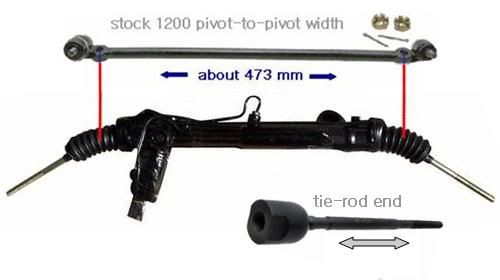
inner dimension: 473mm (18.6") for B110 (about 559mm for B310)
- To prevent excessive bump steer, the ends of the gearbox linkage (where it meets the tie rod ends) must be equal to or less than the distance between the LCA inner pivots. (compare to inner rod ends on the original drag link).
- No bump steer may contribute to oversteer in some cornering conditions. With race cars this is OK (and racers will tune out excessive oversteer in others parts of the suspension), but a street car wants a slight understeer to help prevent easy spinouts. A typical value is two degrees per metre for the front wheels.
- Excessive bump steer causes the steering wheel to jerk when going over bumps, and to wander left and right while driving
- NOTE: Many factory cars have a bit more bump steer than needed due to engineering compromises.
- Most important: The up-and-down relationship of the new gearbox matters. It should be in the same plane as the ends of the Steering Knuckles during actual driving
- Bump steer can be made to induce toe out in jounce by lifting the rack if the rack is in front of the axle. The reverse applies if the rack is behind the axle. Usually only small adjustments (say 3mm) are required.
- For race cars, the designer may choose to match this to a cornering condition, or something other than "normal driving"
Ackermann steering geometry
- For good conering, precise Ackermann steering geometry agles of the steering arms is required. True ackerman is where the steering arms point to the mid-point of the rear axle centerline. This is most important for low-speed cornering.
-
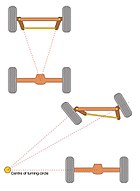
- This is important for gearbox swaps as well as Strut Swaps
-
Some race cars use reverse Ackermann geometry to compensate for the large difference in slip angle between the inner and outer front tires while cornering at high speed. The use of such geometry helps reduce tire temperatures during high-speed cornering but compromises performance in low speed manoeuvres.
The good news is: if you use stock Datsun 1200 Steering Arms, the correct Ackermann is already built in. Just keep the toe-in stock and align the rack along the original axis of the cross rod and she'll be golden.
For more information, see wikipedia:Ackermann steering geometry
General Swap Information
Can a junkyard part be modified to work?
Basically, if you can duplicate the original steering geometry, it should work fine. If you can place the rack in the same plane as the original cross-rod (both up/down and forward/backwards).

The key here is the pivot-to-pivot point. If you get a rack smaller than this, you can easily extend the pivot width via spacers/studs -- without modifying/cutting the rack itself.
- Pivot width: 473 mm (18.6 inches)
As for the length of the tie rod assemblies (inner + outer tie rods), many seem highly customizable, with long sections of threads that could be shortened without need of re-threading. Many of the inners are 14mm threads, so you can mix-and-match to find a close length. Many use 12mm outer threads, so the stock 1200 outer tie-rods could be re-used.
So which boxes are narrow enough?
Potential Source Racks
In selecting a steering rack, there are some considerations:
- It should to be a Rear-steer box, as the original cross rod is behind the crossmember and there is space there to fit a rack.
- Swing of box -- how far does it move from side to side? What is the distance the stock cross-rod traverses? Many racks have a short throw, which will increase your turning circle.
Narrow Enough
Double-check the measurements.
GM Opel-built Holden Barina Too narrow. Can you space out the inner tie-rods?
Nissan B11 48001-04A01 Overall Length: 1,110mm [283+283+544?] Side Rod 48521-35A06 (B11/B12/N13/S13) Length: 283mm Inner thread: 14*1.5 Outer thread: 12*1.25
1983 Civic ~530 mm pivot to pivot
FIAT X1/9 pivots 20.75"
Too Wide
Convert to center pivot use?
1997 Corolla ~570 mm pivot to pivot
Subaru DL? ~21 inches pivot to pivot ATSCO 6826 MANUAL brat, DL, GL, GLF, RX, 1.8, 1.6 1980-1982 SUBARU ALL SUBARU-All Engines 1983-1984 SUBARU ALL SUBARU-All Engines 1985-1989 SUBARU ALL SUBARU-All Engines 1990-1991 SUBARU LOYALE-All Engines YUGO YUGO-All Engines (86 - 87) YUGO YUGO-All Engines (88 - 89) YUGO YUGO-All Engines (90 - 92) 1980-1987 SUBARU BRAT-All Engines A-1 CARDONE Part # 242605 ATSCO Part # 6826 ACDelco ACS1663
Chevette 1980 25.5 pivots (can it be reduced)? 3.75 turns lock to lock with 6" of rack travel 1.6" per turn Very very slow A-1 CARDONE Part # 231602 ATSCO Part # 6805 ACDELCO Part # 3616360
Geo Metro/Suzuki Swift pivots ~23"

![[Datsun 1200 encyclopedia]](/wiki/upload/wiki.png)
